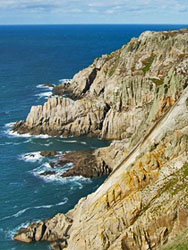The majority of Lundy - a small island in the Bristol Channel - consists of megacrystic granite emplaced into Devonian Morte Slates during the Eocene Epoch (56 to 33.9 million years ago). It is the sole English granite representative of the British Tertiary Volcanic Province associated with the opening of the Atlantic Ocean. This granite originated both from partial mantle melting resulting in turn from extensional forces, as did for example the more northerly rocks of Skye, Rum and Arran which were formed by the same events, and - uniquely - partly from the same lower crustal material as the Cornubian Batholith which it resembles.
 The slates (chlorite-grade greenschists) of the island’s south-eastern extent are of great interest in their own right – There is a close upright folded syncline around Hell’s Gate, where the core is dramatically contorted, with less acute folding elsewhere. The boundary between these slates and the granite results from a fault, and there is no contact metamorphism here. The slates are in fact probably no more than 100 m thick.
The slates (chlorite-grade greenschists) of the island’s south-eastern extent are of great interest in their own right – There is a close upright folded syncline around Hell’s Gate, where the core is dramatically contorted, with less acute folding elsewhere. The boundary between these slates and the granite results from a fault, and there is no contact metamorphism here. The slates are in fact probably no more than 100 m thick.
Both the granite and slates have been intruded by a dyke swarm (a series of injections of magma) which is slightly younger than the granite and may well originate from a magma chamber not far below the surface 2 to 3 km west of Lundy. The dykes demonstrate increasing fractionation of the magma to dolerites, trachytes and rhyolites. Dykes are clearly visible in places in the cliffs with one dyke forming a face just below ‘Marisco’ Castle.
One very interesting feature of Lundy is the Earthquake, between the island’s Quarter Wall and Halfway Wall, a fissured area which is reputed to have faulted at the time of the Great Lisbon Earthquake of 1755. It is more likely, however, to be the result of mining or possibly of earlier tectonic activity.
Text courtesy of Naomi Stevenson